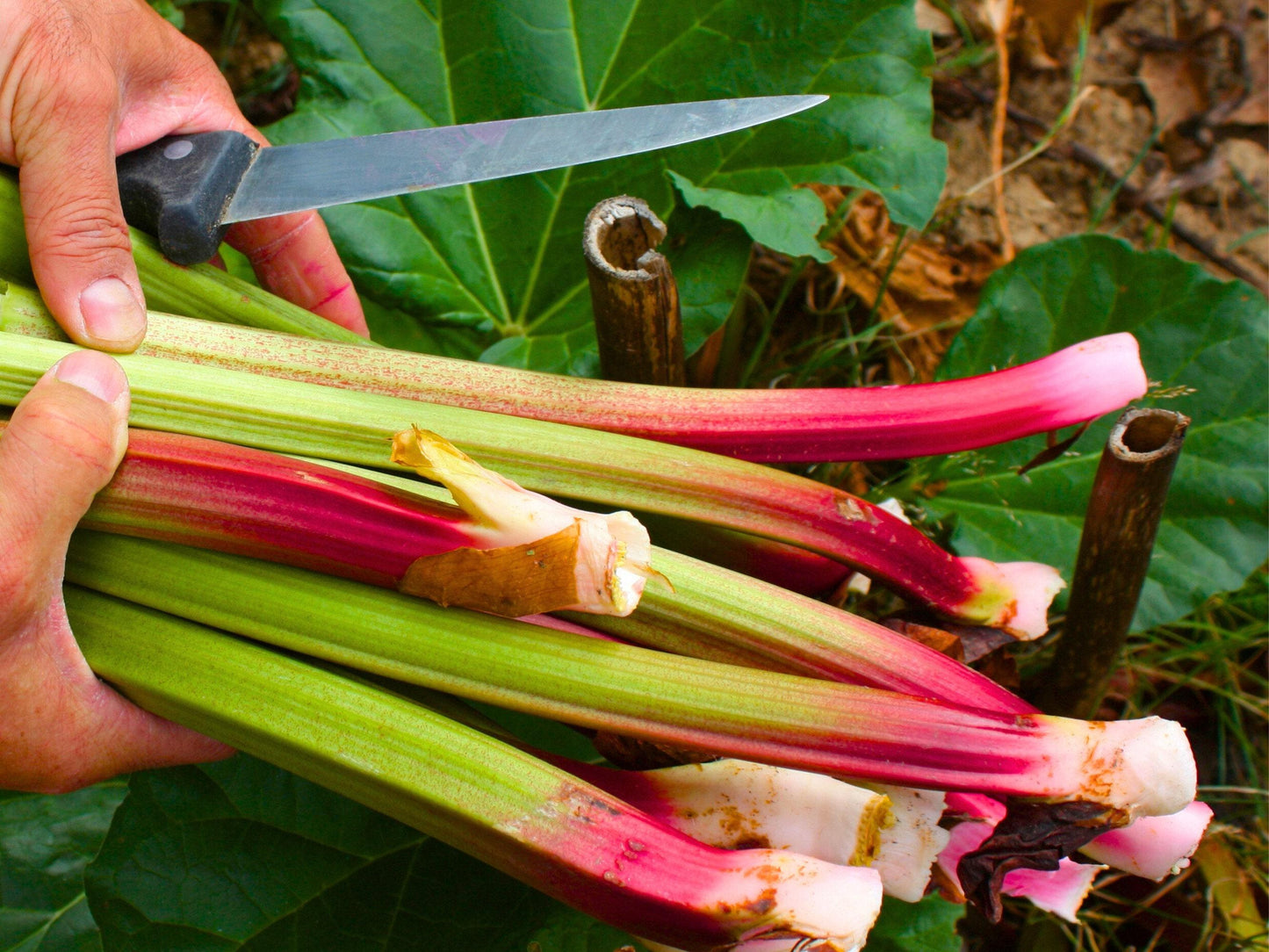Glaskin's Perpetual Heirloom Rhubarb boasts early maturity and an extended harvest period. With its naturally low oxalic acid content, it offers a tart flavor without bitterness. Starting seeds indoors early allows for late-season harvesting in the first year. To promote robust root growth and a vigorous return the next summer, it's advisable to leave some leaves unharvested. The thick, succulent stems, ranging from 12 to 14 inches in length, display a delightful combination of pink, green, and red markings. It's renowned as the top choice for late-year harvesting among rhubarb varieties.
Potentially a good variety for those in the deep south when grown as an annual. One of the only varieties of rhubarb that comes true from seed. This is the fastest growing, all purpose rhubarb.
• Scroll down for detailed growing info •
All Nimble NiteCap Seeds are:
• Heirloom
• Organic
• Non-GMO
• Open Pollinated
• Untreated
• US Grown
• growing instructions included
• Regular testing is conducted to uphold the highest germination standards, all the while employing appropriate seed storage techniques.
Sustainable Packaging & Shipping:
• NimbleNitecap seeds are packed in eco-friendly, compostable seed packets. Seed packets are printed in house with vegetable-based inks on biodegradable, recycled materials. (Small plastic bags are infrequently used to prevent the loss of very small seeds.)
• All orders are carefully packed and shipped with tracking via USPS First Class (or Priority, if selected) in padded ECOENCLOSE recycled and reusable mailers, or recycled boxes to protect your items in transit.
Most orders ship out the same or next business day! Please note that this time may be extended during peak season.
• FREE SHIPPING on all orders of $35 or more. Flat Rate shipping no matter how many packets you order.
• DIRECTIONS •
SEASON
Perennial
USDA ZONES
3 - 8
HEIGHT
24 - 36 inches
BLOOM SEASON
Late spring through late summer
BLOOM COLOR
Green
ENVIRONMENT
Full sun
SOIL TYPE
pH 6.2 - 6.8 well drained soil
LATIN NAME
Rheum Rhabarbarum
AVERAGE GERM TIME
7 - 14 days
PLANT SPACING
36 - 48 inches
~ sowing ~
Sow in late winter to spring or late summer to autumn.
The seeds are encased in a rather large paper-like shell. Soak the seeds in water for a few hours before planting. Plant the seeds in a peaty mixture or into peat pots to making transplanting them easier and then put them in a sunny window. Rhubarb seeds germinate quickly.
Sow indoors in early spring and transplant or direct sow about 8 weeks after the last frost date where plants are to grow permanently. Optimal soil temperature: 60-75°F. Sow 1″ deep, but plan for large plants. Seeds should sprout in 5-10 days. One plant will typically satisfy the needs of one household.
For spring sown seedlings, transplant outside when the plants about 3 to 4in tall.
For autumn sown seedlings, plant them outside in early April, as the weather turns warmer.
Protect the seedlings from the bright sun. Be careful to not over water it as rhubarb can get root rot if the ground is too wet.
Space 36in apart. Much smaller will seriously crowd the plants, result in a diminished crop and increase the likelihood of spreading disease. A two to three year old plant can easily grow to 48in in diameter and 36in tall.
Plant the roots with the crown bud 2in below the surface of the soil. Dig the hole for the crown extra large and mix composted manure or peat moss with the soil to be placed around the roots. Firm the soil around the roots but keep it loose over the buds. Water and fertilize the crowns after planting.
~ growing ~
Ideal pH: 6.0-6.8. Any well-drained, moderately fertile garden soil will do. Mulch around plants in fall with finished compost or well rotted steer manure. Choose a sunny spot.
Rhubarb is cold hardy and drought tolerant. After growth stops in the fall, the plants go dormant, and require a period below 40°F to stimulate good spring bud growth. In the second year, remove flower stalks as they appear. Divide plants every 4-5 years. A well maintained plant should produce for over a decade.
Good garden drainage is essential in growing rhubarb, planting in raised beds helps ensure against rotting of the crowns. Crowns will have longevity of many years, but because of diseases and insects, it is normal to reset a bed after four to five years
~ harvesting ~
Remove the flower stalks as they are seen. During the first year of planting, the stalks should not be picked, since food from the leaves is needed to nourish the roots for the next year's growth. A light picking may be taken during the year following planting, following that: the entire plant may be harvested.
When harvesting rhubarb, the first step is to cut the stalks at the soil line or simply pull them out individually. All of the stalks of a plant may be harvested at one time, or pulled out selectively over a 4 to 6 week period. After the stalks are cut, the leaves may be removed.
Flowering will reduce the vigour of the plant. The flower and seed stalks should be cut out as soon as they start forming. The plant may still continue to produce the flower stalks so keep cutting. The plants do not become poisonous after flowering starts. The leaves themselves are always poisonous; the leaf stalks can still be cut and used.
Established clumps will have to be trimmed every 4 to 5 years or when the stalks get small and spindly or when the crown is visibly crowded. This will help the plant to keep growing nice thick stems. This is done by digging around and trimming the crown down to 4 or 5 buds. You can also use this opportunity to divide your plant into more plants.



















